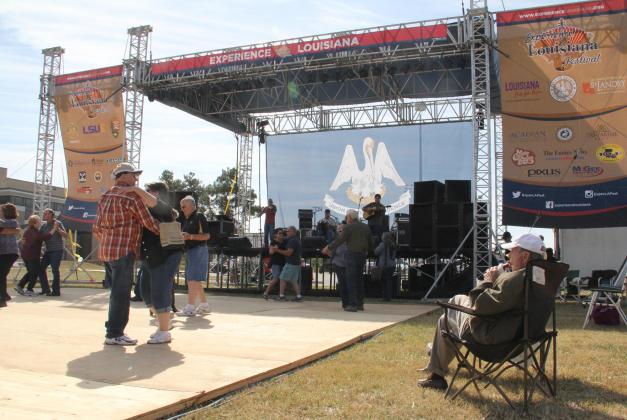
Jim Bradshaw
Harvest season is a busy time for south Louisiana farmers and ranchers, but it is also a busy time for folks who like to eat, dance, and generally pass a good time.
That’s because it is also the time for harvest festivals, when we take the opportunity to have some fun when the work is done.
Most of the festivals, especially the older ones, began as local celebrations and retain their local flavor. But most of them also play a significant role in bringing visitors who, for some reason unfathomable to me, grow fascinated just watching us be who we are.
Looking at the calendar of the Louisiana Fairs and Festival Association, it becomes obvious that we throw annual parties to celebrate practically everything we eat, do, or listen to. But the first festivals were based on something we raised on the farm or pulled from the Gulf, and most of them, besides offering good fun, had the serious purpose of selling south Louisiana’s bounty to a wider market.
1937 seems to have been an especially event-full year. The rice and sugar festivals were launched that year in Crowley and New Iberia, and the Morgan City celebration now known as the Shrimp and Petroleum Festival began then, or maybe even earlier.
The first rice festival was held on Oct. 5, 1937, and was called the National Rice Festival. It was renamed the International Rice Festival in 1946, maybe because GIs coming home from the war had seen more of the world. It may be only coincidental that the first Sugar Cane Festival was held in 1937, but that was the year President Franklin Roosevelt pushed the Sugar Act of 1937 through Congress as part of his plan to beat the Depression by promoting agriculture.
The first recorded celebration of Morgan City’s shrimp industry was a Labor Day parade by frog and alligator hunters, oystermen, shrimpers and other members of the Gulf Coast Seafood Producers and Trappers Association. They were happy because shrimp boats that had once been limited to hauls of small brown shrimp from coastal waters were venturing into the deep Gulf to bring back fat, white jumbo shrimp. Morgan City proclaimed itself Jumbo Shrimp Capital of the World in 1937 and held the first blessing of the shrimp fleet. It became the Shrimp and Petroleum Festival in 1967.
The first Yambilee was held in Opelousas in 1946 to “stimulate local and national interest in Louisiana farm produce” and to “provide colorful programs of entertainment capable of generating nationwide publicity,” according to its organizers. Roy Theriot, who later became state comptroller, was manager of the Abbeville Chamber of Commerce when he organized the first Dairy Festival. Its name was changed to the Louisiana Cattle Festival in 1979, mainly because dairy farming was fast fading around here.
The Delcambre Shrimp Festival was first known as the Iberia Parish Shrimp Festival and Agricultural Fair and was born as a project to raise money for the fire department in Delcambre. Its name was changed in 1974. Ville Platte’s Cotton Festival and its unique Tournoi have been going strong since 1953, when a bunch of World War II vets were looking for a way to promote the Evangeline Parish crop.
Congressman T.A. Thompson was a big promoter of the Louisiana Fur and Wildlife Festival, held since 1955 in Cameron. He got the idea after a Cameron Parish trapper competed in the National Fur Skinning Contest. The legislature named Breaux Bridge the Crawfish Capital of the World in 1959, so it was only natural that the critter became the centerpiece of the celebration of the town’s bicentennial in 1960.
The Swine Festival has been a fixture in Basile since 1966, and the first Frog Festival was held in Rayne in 1973. The frog industry was all but dead by then, but newspaper editor and town matriarch Myrta Fair Craig decided Rayne needed a festival centered on frogs, and nobody in town had the gumption to tell her otherwise.
Since then, festivals have sprung up to celebrate ducks, (Gueydan), rabbits (Iowa), catfish (Washington), étouffée (Arnaudville), boudin (Scott), cracklins (Parks, Port Bare), hot peppers (St. Martinville), the omelet (Abbeville), mayhaws (Starks), sweet dough pies (Grand Coteau), barbecue (DeQuincy), smoked meats, (Ville Platte), Cajun, Zydeco, Swamp Pop and all sorts of music (all sorts of places), buggies (Church Point), and even pirates (Lake Charles).
I’m sure I’ve missed some, but the festival lovers won’t. It’s the peak season to celebrate south Louisiana, and if you want to start one but think everything is taken, just look around. I’m sure there are as few other things worth dancing over — or maybe somebody should organize the Nothing in Particular Festival. Just put out some food and provide good music; in south Louisiana we’ll party for the flimsiest of reasons, and people from all over will come to watch.
A collection of Jim Bradshaw’s columns, Cajuns and Other Characters, is now available from Pelican Publishing. You can contact him at jimbradshaw4321@gmail.com or P.O. Box 1121, Washington LA 70589.
